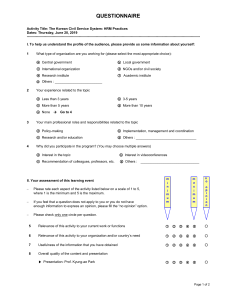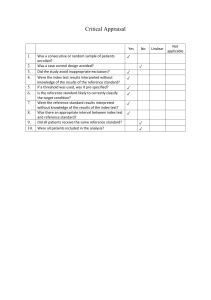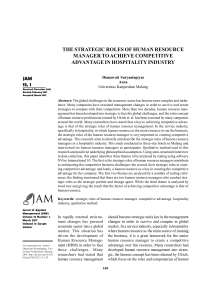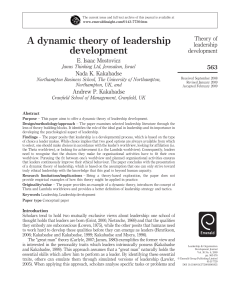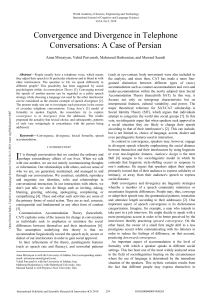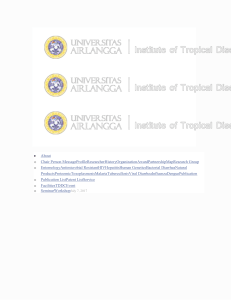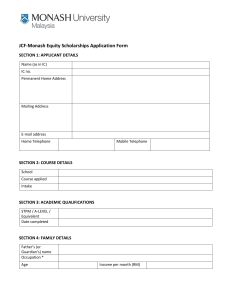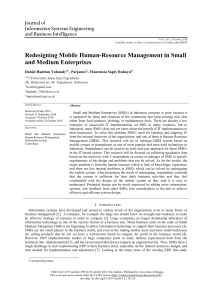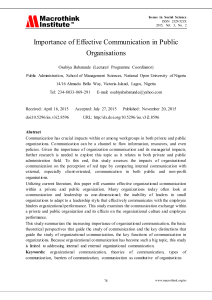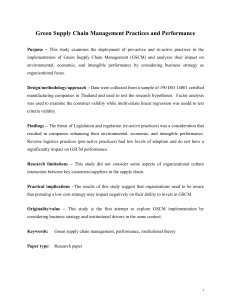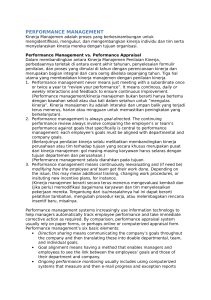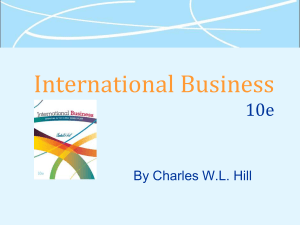Uploaded by
common.user8572
HRM Practices and Organizational Innovation: Mediating Role of KM Effectiveness
advertisement
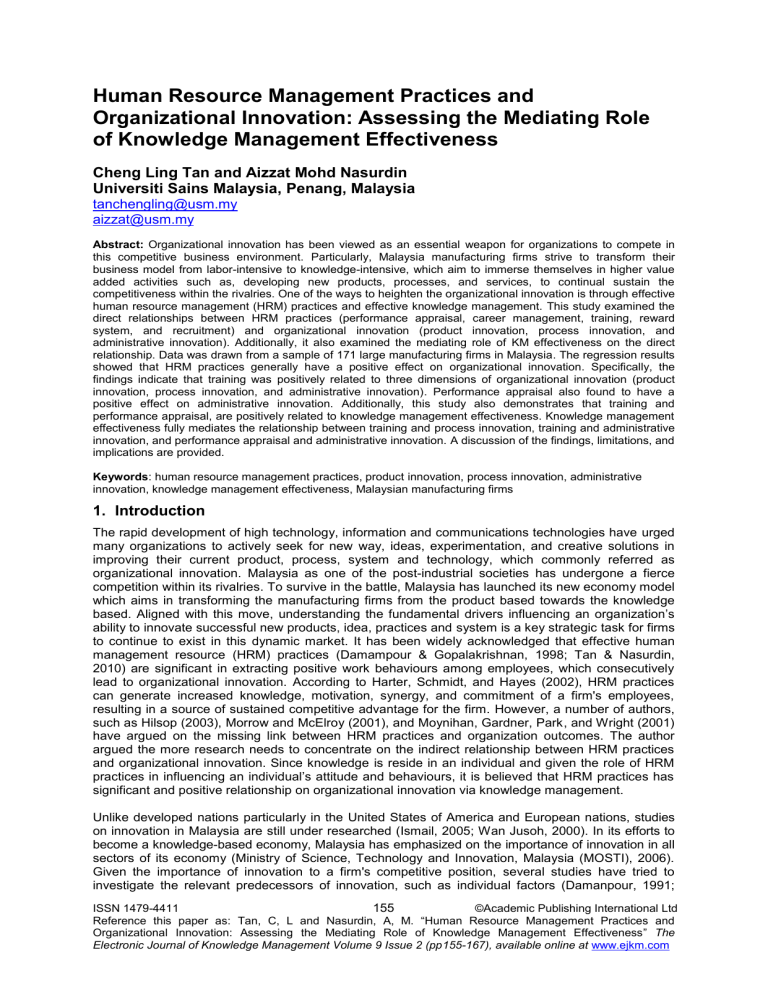
Human Resource Management Practices and Organizational Innovation: Assessing the Mediating Role of Knowledge Management Effectiveness Cheng Ling Tan and Aizzat Mohd Nasurdin Universiti Sains Malaysia, Penang, Malaysia [email protected] [email protected] Abstract: Organizational innovation has been viewed as an essential weapon for organizations to compete in this competitive business environment. Particularly, Malaysia manufacturing firms strive to transform their business model from labor-intensive to knowledge-intensive, which aim to immerse themselves in higher value added activities such as, developing new products, processes, and services, to continual sustain the competitiveness within the rivalries. One of the ways to heighten the organizational innovation is through effective human resource management (HRM) practices and effective knowledge management. This study examined the direct relationships between HRM practices (performance appraisal, career management, training, reward system, and recruitment) and organizational innovation (product innovation, process innovation, and administrative innovation). Additionally, it also examined the mediating role of KM effectiveness on the direct relationship. Data was drawn from a sample of 171 large manufacturing firms in Malaysia. The regression results showed that HRM practices generally have a positive effect on organizational innovation. Specifically, the findings indicate that training was positively related to three dimensions of organizational innovation (product innovation, process innovation, and administrative innovation). Performance appraisal also found to have a positive effect on administrative innovation. Additionally, this study also demonstrates that training and performance appraisal, are positively related to knowledge management effectiveness. Knowledge management effectiveness fully mediates the relationship between training and process innovation, training and administrative innovation, and performance appraisal and administrative innovation. A discussion of the findings, limitations, and implications are provided. Keywords: human resource management practices, product innovation, process innovation, administrative innovation, knowledge management effectiveness, Malaysian manufacturing firms 1. Introduction The rapid development of high technology, information and communications technologies have urged many organizations to actively seek for new way, ideas, experimentation, and creative solutions in improving their current product, process, system and technology, which commonly referred as organizational innovation. Malaysia as one of the post-industrial societies has undergone a fierce competition within its rivalries. To survive in the battle, Malaysia has launched its new economy model which aims in transforming the manufacturing firms from the product based towards the knowledge based. Aligned with this move, understanding the fundamental drivers influencing an organization’s ability to innovate successful new products, idea, practices and system is a key strategic task for firms to continue to exist in this dynamic market. It has been widely acknowledged that effective human management resource (HRM) practices (Damampour & Gopalakrishnan, 1998; Tan & Nasurdin, 2010) are significant in extracting positive work behaviours among employees, which consecutively lead to organizational innovation. According to Harter, Schmidt, and Hayes (2002), HRM practices can generate increased knowledge, motivation, synergy, and commitment of a firm's employees, resulting in a source of sustained competitive advantage for the firm. However, a number of authors, such as Hilsop (2003), Morrow and McElroy (2001), and Moynihan, Gardner, Park, and Wright (2001) have argued on the missing link between HRM practices and organization outcomes. The author argued the more research needs to concentrate on the indirect relationship between HRM practices and organizational innovation. Since knowledge is reside in an individual and given the role of HRM practices in influencing an individual’s attitude and behaviours, it is believed that HRM practices has significant and positive relationship on organizational innovation via knowledge management. Unlike developed nations particularly in the United States of America and European nations, studies on innovation in Malaysia are still under researched (Ismail, 2005; Wan Jusoh, 2000). In its efforts to become a knowledge-based economy, Malaysia has emphasized on the importance of innovation in all sectors of its economy (Ministry of Science, Technology and Innovation, Malaysia (MOSTI), 2006). Given the importance of innovation to a firm's competitive position, several studies have tried to investigate the relevant predecessors of innovation, such as individual factors (Damanpour, 1991; ISSN 1479-4411 155 ©Academic Publishing International Ltd Reference this paper as: Tan, C, L and Nasurdin, A, M. ―Human Resource Management Practices and Organizational Innovation: Assessing the Mediating Role of Knowledge Management Effectiveness‖ The Electronic Journal of Knowledge Management Volume 9 Issue 2 (pp155-167), available online at www.ejkm.com Electronic Journal of Knowledge Management Volume 9 Issue 2 2011 Kimberly & Evanisko, 1981), environmental factors (Damanpour, Szabat, & Evan. 1989; Miller & Friesen, 1982), and organizational structure (Damanpour, 1991; Thompson, 1965). However, there is still unexplored research area about particular organizational practices that may influence the organizational innovation. According to Tan and Nasurdin (2010), an organization’s approach of HRM practices has an influential effect on organizational innovation. HRM practices set the tone and condition of the employer-employee relationship which can encourage the employees to become more innovative (Rousseau & Greller, 1994). If HRM practices properly realigned, it can play a vital role in contributing to the management of organizational knowledge, and innovation will be realized through the ability to use the knowledge to identify and pursue the opportunity. This postulates that knowledge management effectiveness allowing employees to generate knowledge within their sphere of influence, and extent as of shared knowledge influences the organizational innovation (Dobni, 2006). Against this backdrop, the goal of this study was to examine the role of knowledge management effectiveness mediating the relationship between HRM practices (performance appraisal, career management, training, reward system, recruitment) and organizational innovation (product innovation, process innovation and administrative innovation) within the Malaysian manufacturing industry. 2. Organizational innovation Organizational innovation has been widely defined as the creation of new idea and new behaviour to the organization (Damanpour & Gopalakrishnan, 2001). The dimensions of organizational innovation are extremely complex and multiple; it can be reviewed from two aspects: (1) breadth of innovation, which includes policies, system, administrative, processes, products, services, and others; (2) depth of innovation, which includes the importance, the degree of influence, effect on long term profitability, and others (Chuang, 2005). Fundamentally, there are two distinctive types of organizational innovation have been classified in most literature, namely technological innovation, and administrative innovation (i.e. Chuang, 2005; Damanpour & Evan, 1984; Damanpour et al., 1989; Tan & Nasurdin, 2010). Chuang (2005) has further categorized technological innovation into secondary dimensions: product innovation and process innovation; while administrative innovation remains distinct from the other two. Under Mavondo, Chimhanzi and Stewart’s (2003) study, organizational innovation was distinctively classified into three dimensions, namely: product innovation, process innovation and administrative innovation. The present study divided organizational innovation into the main dimensions of product innovation, process innovation and administrative innovation based on the most prevalent types that have been discussed in the previous literatures (i.e. Chuang, 2005; Damanpour, 1991; Damanpour & Evan, 1984; Damanpour et al., 1989; Mavondo et al., 2003; Tan & Nasurdin, 2010). Product innovation, process innovation and administrative innovation are the important predecessors for manufacturing firms and have the equal capability to improve performance or effectiveness, solve problems, add value, and create competitive advantage (Cooper, 1998; Damanpour, 1996). Given the importance of product innovation, process innovation and administrative innovation in enhancing manufacturing firm performance, therefore, the organizational innovation is operationalized to be multidimensional comprising of these three types of organizational innovation. Product innovation is defined as the development and commercialization of new product to create value and meet the needs of the external user or the needs of the market (Damanpour & Gopalakrishnan, 2001). Product innovation is a systematic work process which drawing upon existing knowledge gained from research and practical experiences directed towards the production of new materials, products and devices, including prototypes. On the other hand, process innovation is viewed as a creation of new process or improvement to existing process (Leonard & Waldman, 2007). Process innovation involves the implementation of a new significantly improved production or delivery method, which includes changes in techniques, equipment and/or software (Bi, Sun, Zheng & Li, 2006). Administrative innovation is viewed as performance derived from the changes to organizational structure and administrative process, reward and information system, and it encompasses basic work activities within the organization which is directly related to management (Chew, 2000; Damanpour & Evan, 1984). Administrative innovation requires organizations to have verifiable routines and procedures in place for product design, manufacture, delivery, service and support (Brunsson, Jacobsson, Ahrne, Furnsten, Garsten, Hennin, Sahlin-Andersson & Hallström, 2000). Since manufacturing firms operate in the highly complex environment on the basis of internal operations efficiency and effectiveness, product innovation, process innovation and administrative innovation can be considered as the pivotal sources of competitive advantage. www.ejkm.com 156 ©Academic Publishing International Ltd Cheng Ling Tan and Aizzat Mohd Nasurdin 3. Human Resource Management (HRM) practices As the world is becoming more competitive and unstable than ever before, manufacturing-based industries are seeking to gain competitive advantage at all cost and are turning to more innovative sources through HRM practices (Sparrow, Schuler, & Jackson, 1994). HRM practices have been defined in several aspects. Schuler and Jackson (1987) defined HRM practices as a system that attracts, develops, motivates, and retains employees to ensure the effective implementation and the survival of the organization and its members. Besides, HRM practices is also conceptualized as a set of internally consistent policies and practices designed and implemented to ensure that a firm’s human capital contribute to the achievement of its business objectives (Delery & Doty, 1996). Likewise, Minbaeva (2005) viewed HRM practices a set of practices used by organization to manage human resources through facilitating the development of competencies that are firm specific, produce complex social relation and generate organization knowledge to sustain competitive advantage. Against this backdrop, we concluded that HRM practices relate to specific practices, formal policies, and philosophies that are designed to attract, develop, motivate, and retain employees who ensure the effective functioning and survival of the organization. Among the main approaches to develop HRM: ―universal‖ or ―best practice‖ approach (Huselid, 1995); strategic HRM practices approach (Delery & Doty, 1996); contingency approach (Dyer, 1985; Schuler, 1989); and configuration approach (Wright & McMahan, 1992), previous studies revealed that HRM practices, which were related to organizational innovation, mainly focused on ―universal‖ or ―best practice‖ approach. A review of the literature demonstrates five common practices that have been consistently associated with innovation, encompassing performance appraisal, career management, reward system, training, and recruitment (Gupta & Singhal, 1993; Jiménez-Jiménez & Sanz-Valle, 2005; Kydd & Oppenheim, 1990; Laursen & Foss, 2003; Shipton, Fay, West, Patterson & Birdi, 2005). 4. Knowledge management effectiveness The learning process occurred to improve the stock of knowledge available to the organization and to amplify the value of its intellectual assets, such as innovation capital when knowledge is acquired and applied. If an organization demonstrates competence in knowledge management, it can be considered as having a knowledge management-orientation (Darroch & McNaughton, 2002). Knowledge management has been broadly defined from many perspectives. Wiid (1997) viewed as a set of activities that lead an organization in acquiring knowledge both internally and externally. According to Salisbury (2003), knowledge management is defined as the deployment of a comprehensive system that enhances the growth of an organization’s knowledge. In an effort to expand the knowledge management discipline, knowledge management can be defined as the management functions that encompass the creation of knowledge, management of the flow of knowledge within the organization, and usage of knowledge in an effective and efficient manner for the long-term benefit of the organization (Darroch & McNaughton, 2001). Hence, knowledge management effectiveness is regarded as a management discipline which focused on the development and usage of knowledge to support the achievement of strategic business objectives. Knowledge management effectiveness can be analyzed from a process perspective (Gold, Malhotra & Segars, 2001; Zheng, 2005). In general, knowledge management effectiveness can be conceived as the effectiveness of an organization in managing the knowledge acquired, shared, and applied by its employees. In summary, knowledge management effectiveness is conceived as a process to enhance knowledge application to achieve organizational innovation for improving business performance. Organizations that effectively manage their knowledge within organization will have higher organization innovation in turn to achieve breakthrough competitive advantage. 5. Human Resource Management (HRM) practices and Organizational Innovation (OI) Resource-based view (RBV) and Ability, Motivation and Opportunity (AMO) theory appear to be the most popular theories applied in the studies that link HRM and performance (Paauwe & Boselie, 2005). RBV argues that human resource is one of the organization’s resources, a subset of which enable them to achieve a competitive advantage, and a subset of those that lead to superior longterm performance (Barney, 1986; 1991). The AMO theory illustrates that when employees are motivated, they are likely to perform better, leading to higher firm performance (Paauwe & Boselie, 2005). HRM practices play an influential role in motivating employees to exhibit favorable attitudes and behaviors, which are required to support and implement the competitive strategy of an www.ejkm.com 157 ISSN 1479-4411 Electronic Journal of Knowledge Management Volume 9 Issue 2 2011 organization (Hiltrop, 1996). According to Wang (2005), innovative firms treat HRM practices as the organization’s strategy to encourage team responsibilities, enhance organizational culture, and build up customer relationships through participation and empowerment. In turn, it will help to create and market new products and services (Gupta & Singhal, 1993). When firms develop and introduce new product, new process and/or new administrative practices, they require innovative and creative employees, who are flexible, risk taking, and tolerant of uncertainty and ambiguity (Chen & Huang, 2007). These employees are highly recognized in manufacturing industries as they contribute to firm on the basis of market responsiveness, product and process innovation. Therefore, it is important for a firm to implement supportive HRM practices that can motivate and stimulate employees to be innovative. On the basis of arguments put forth by previous scholars (i.e. Gupta & Singhal, 1993; Jiménez-Jiménez & Sanz-Valle, 2005; Kydd & Oppeneheim, 1990; Laursen & Foss 2003; Shipton et al., 2005), we would expect HRM practices to be positively related to organizational innovation. For instance, performance appraisal increase employee commitment and satisfaction since employees are given chance to discuss about their work performance. This, in turn, will lead them to perform greater in innovative activities. In a similar vein, career management assist employees to attain their career goals and objectives. If employees are likely to feel satisfied with their career management, which in turn, lead to motivate them to perform in innovative activities (Delery & Doty, 1996). Training helps employee master knowledge, skill, and ability which would be contribute to innovation in terms of products, production processes, and management practices in daily operation (Schuler & Jackson, 1987). Hence, training develops the knowledge, skill, and ability of employees to perform effectively in their job that will lead to higher organizational innovation. Reward system provides financial reward, promotion and other recognition, in order to motivate employees to take risk, develop successful new products and generate newer ideas (Guptal & Singhal, 1993). Reward system encourages employee to become motivated, thereby increase their participation in contributing innovation ideas, which leading to high organizational innovation. Recruitment involves employing and obtaining appropriate and competent candidates through external sourcing (Sparrow, Schuler & Jaclson, 1994). Recruitment gives greater importance to be attached to fit between person and company culture. Hence, the high level of implementation of recruitment that attaches individual – organizational fit is likely to result in high organizational innovation. Drawing upon the argument given above, thus, our main hypotheses are constructed as follows: H1: The level of HRM practices (performance appraisal, career management, training, reward system, and recruitment) will be positively related to the organizational innovation (product innovation, process innovation and administrative innovation). H1a: The level of HRM practices (performance appraisal, career management, training, reward system, and recruitment) will be positively related to the product innovation. H1b: The level of HRM practices (performance appraisal, career management, training, reward system, and recruitment) will be positively related to the process innovation. H1c: The level of HRM practices (performance appraisal, career management, training, reward system, and recruitment) will be positively related to the administrative innovation. 6. Knowledge management effectiveness as a mediator A number of scholars, such as Hilsop (2003), Morrow and McElroy (2001), and Moynihan et al. (2001) have argued on the missing link between HRM practices and organization outcomes. The missing link between HRM practices and organization outcomes illustrate the existence of a ―black box‖. The ―black box‖ model indicated that there is an unknown apparatus which is apparently invisible in increasing organizational innovation (Marinova & Phillimore, 2003). Knowledge management is recognized as the fundamental activity for obtaining, growing and sustaining intellectual capital in organizations (Marr & Schiuma, 2001). Knowledge management is not only served as predecessor to organizational innovation, but also an intervening mechanism between organizational factors and organizational outcomes. Previous studies have examined the role of knowledge management as a mediator. For instance, Tung’s (2004) study evidenced that knowledge management mediates the relationship between an organization’s culture and structure, and organizational effectiveness. Rashid Alshekaili’s (2011) study reveals that knowledge management mediates the relationship between human capital and innovation performance. Since HRM practices are assumed to be a managerial process that allows firms to manage effectively so as to improve the organizational innovation, it is www.ejkm.com 158 ©Academic Publishing International Ltd Cheng Ling Tan and Aizzat Mohd Nasurdin important to view knowledge management effectiveness as the ―black box‖ underlying the relationship between HRM practices and organizational innovation, which has been omitted in previous studies (i.e. Laursen & Foss, 2003; Shipton et al., 2005). Thus, this study sought to examine the indirect relationship between HRM practices and organizational innovation via knowledge management effectiveness. Therefore, we hypothesized that: H2: Knowledge management effectiveness mediates the relationship between HRM practices (performance appraisal, career management, training, reward system, and recruitment) and organizational innovation (product innovation, process innovation and administrative innovation). H2a: Knowledge management effectiveness mediates the relationship between HRM practices (performance appraisal, career management, training, reward system, and recruitment) and product innovation. H2b: Knowledge management effectiveness mediates the relationship between HRM practices (performance appraisal, career management, training, reward system, and recruitment) and process innovation. H2c: Knowledge management effectiveness mediates the relationship between HRM practices (performance appraisal, career management, training, reward system, and recruitment) and administrative innovation. Based on our discussion of the literature, our research framework is shown in Figure 1. H1 HRM Practices Performance Appraisal Career Management Training Reward System Recruitment Organizational Innovation H2 Knowledge Management Effectiveness H3 Product Innovation Process Innovation Administrative Innovation H4 Figure 1: Research framework 7. Methodology 7.1 Samples In Malaysia, innovating companies were widely distributed in the states of Selangor, Pulau Pinang, Johor, Kedah, Kuala Lumpur, and Perak according to the study by National Survey of Innovation, 2002 – 2004. The samples of this study were derived from Federation of Malaysian Manufacturers (FMM) Directory 2007, and a number of 674 large manufacturing firms were found in these six states. Hence, these 647 large manufacturing firms located in the six states were selected to be the samples of this study. The potential manufacturing firms were given two months to complete the questionnaires. Overall, 171 useable questionnaires were returned and analyzed, representing a response rate of 25.4 percent. 7.2 Method of analysis HRM practices measure comprised of 28 items that included performance appraisal (6 items), career management (6 items), training (4 items), reward system (6 items), and recruitment (6 items). All items were adapted from Argawala (2003). Organizational innovation were measured using 13 items that included product innovation (4 items), process innovation (4 items), and administrative innovation (5 items). The items were adapted from previous researchers (eg. Zhang, 2006; US Bureau of Labor www.ejkm.com 159 ISSN 1479-4411 Electronic Journal of Knowledge Management Volume 9 Issue 2 2011 Statistics, 2008; and Chew, 2000). Knowledge management effectiveness, on the other hand, was comprised of 15 items which were adapted from Zheng (2005). The response format was based on a seven-point Likert scale ranging from (1) 'strongly disagree' to (7) 'strongly agree'. The profile of the participating firms, such as geographic location, type of industries, and ownership of companies were compiled. Above and beyond, the hypotheses of this study were tested using hierarchical regression (Hair, Anderson and Tatham 2006). According to previous studies, organizational innovation can be influenced by firm size and years in operation (Akgun, Keskin, Byrne & Aren, 2007; Jiménez-Jiménez & Sanz-Valle, 2005). For this reason, these two variables were controlled in the regression analyses. Reliability coefficients of the study variables are as follows: career management (0.91), training (0.89), performance appraisal (0.87), reward system (0.87), recruitment (0.82), Knowledge management effectiveness (0.96), product innovation (0.89), process innovation (0.88), and administrative innovation (0.85). These values exceeded Sekaran’s (2003) acceptable level of 0.60. 8. Results 8.1 Profile of participating firms The profile of participating companies is shown in Table 1. Of 171 large participating manufacturing firms, majority of them are from Pulau Pinang (38.0%), followed by Selangor (26.9%) and Johor (13.5%). The remaining participating firms with 11.1 % were from Perak, 6.4% were from Kedah, and 4.1% from Kuala Lumpur. With regard to type of industry, the majority of responding companies are from electronics/electrical industry (26.9%), followed by others industry (25.7%), fabricated metal product (10.5%), and rubber and plastics product (8.8%). Remaining responding companies are from textile (5.9%), food and beverages (4.7%), motor vehicles (4.7%), paper and paper products (4.1%), chemicals and chemical products (2.9%), medical and precision (2.3%), recycling (0.6%), and machineries (0.6%). Pertaining ownership of company, 49.1 percent of the responded companies are 100% local owned company, followed by 100% foreign owned company (38.6%), and joint ventures (12.3%). Table 1: Profile of participating companies Variable Location of Factory Kedah Perak Pulau Pinang Selangor Kuala Lumpur Johor Type of Industry Electronics / Electrical Chemicals & Chemical products Textile Rubber & plastic products Food & beverages Fabricated metal products Motor vehicles Basic metal Recycling Paper & paper products Medical & precision Machineries Others Ownership of Company 100% foreign company 100% local company Joint venture company Frequency % 11 19 65 46 7 23 6.4 11.1 38.0 26.9 4.1 13.5 46 5 10 15 8 18 8 4 1 7 4 1 44 26.9 2.9 5.9 8.8 4.7 10.5 4.7 2.3 0.6 4.1 2.3 0.6 25.7 66 84 21 38.6 49.1 12.3 Two control variables in this study were computed and the results showed that the mean of the firm size is 1,162.4 (SD = 1779.68) with the firm size ranged between 150 and 11,000 employees. The mean of years in operation for the firms is 23.1 years (SD =10.15) with the range between minimum of 4 years and maximum 51 years. www.ejkm.com 160 ©Academic Publishing International Ltd Cheng Ling Tan and Aizzat Mohd Nasurdin 8.2 Descriptive statistics Descriptive statistics such as mean scores, standard deviations, reliabilities, and intercorrelations of the study variables are shown in Table 2 and Table 3 respectively. As shown in Table 2, 34 out of 36 intercorrelations are statistically significant. Correlations among HRM practices dimensions are statistically significant, ranging from r = 0.44 (p < 0.01) to r = 0.66 (p < 0.01). Besides, correlations between HRM practices and organizational innovation are found to be significant, ranging from r = 0.14 (p < 0.05) to r = 0.49 (p < 0.01). Correlation between reward system and product innovation (r = 0.06, p > 0.05), and recruitment and process innovation (r = 0.11, p > 0.05), however, are low and insignificant. Correlation among organizational innovation dimensions are statistically significant, ranging from r = 0.47 (p < 0.01) to 0.55 (p < 0.01). All correlations between knowledge management effectiveness with HRM practices, and also organizational innovation are significant and positive. The correlation between HRM practices and knowledge management effectiveness ranged from r = 0.45 (p < 0.01) to r = 0.66 (p < 0.1). Besides, the correlation between knowledge management effectiveness and organizational innovation ranged from r = 0.42 (p < 0.01) to r = 0.63 (p < 0.1). Table 2: Intercorrelation matrix PDI PCI ADI PA CM TR RS RC 1. PDI 1.00 2. PCI 0.471** 1.00 3. ADI 0.535** 0.552** 1.00 4. PA 0.283** 0.264** 0.466** 1.00 5. CM 0.265** 0.297** 0.455** 0.648** 1.00 6. TR 0.352** 0.362** 0.487** 0.585** 0.660** 1.00 7. RS 0.060 0.240** 0.345** 0.603** 0.570** 0.555** 1.00 8. RC 0.140* 0.112 0.316** 0.444** 0.628** 0.468** 0.480** 1.00 9. KME 0.417** 0.443** 0.625** 0.563** 0.652** 0.663** 0.445** 0.514** KME 1.00 **. Correlation is significant at the 0.01 level (1-tailed). *. Correlation is significant at the 0.05 level (1-tailed). Note: PDI denotes product innovation, PCI denotes process innovation, ADI denotes administrative innovation, PA denotes performance appraisal, CM denotes career management, TR denotes training, RS denotes reward system, RC denotes recruitment, and KME denotes knowledge management effectiveness. With reference to Table 3, the participating manufacturing firms judged their level of administrative innovation (M = 5.23, S.D. = 0.94), product innovation (M = 5.10, S.D. = 0.94) and process innovation (M = 5.05, 0.89) to be relatively high. The level of performance appraisal (M = 5.20, S.D. = 1.04) was found to be slightly higher than training (M = 5.00, S.D. = 1.02) career management (M = 4.70, S.D. = 1.04), reward system (M = 4.47, S.D. = 1.06), recruitment (M = 4.21, S.D. = 0.97), and knowledge management effectiveness (M = 4.86, S.D. = 0.79). Table 3: Mean scores and standard deviations for the study variables Variables Mean (M) Performance Appraisal Career Management Training Reward System Recruitment Knowledge Management Effectiveness Product Innovation Process Innovation Administrative Innovation 5.20 4.70 5.00 4.47 4.21 4.86 5.10 5.05 5.23 www.ejkm.com 161 Standard Deviation (SD) 1.04 1.04 1.02 1.06 0.97 0.79 0.94 0.89 0.94 ISSN 1479-4411 Electronic Journal of Knowledge Management Volume 9 Issue 2 2011 8.3 Hypotheses testing A two-step hierarchical regression was conducted to test hypothesis H 1 and sub-hypotheses H1a to H1c. The two control variables (firm size and years in operation) were entered in step 1. In step 2, the five HRM practices variables (performance appraisal, career management, training, reward system, and recruitment) were entered. The results of the regression analysis between HRM practices and organizational innovation (product innovation, process innovation and administrative innovation) are portrayed in Table 4. Table 4: Results of regression analysis: effect of HRM practices on organizational innovation (product innovation, process innovation and administrative innovation). Predictors Step 1: Control variables Firm Size Years In Operation Step 2: HRM Practices Performance appraisal Career management Training Reward system Recruitment 2 R 2 Adjusted R 2 ΔR F-value Δ F-value Product Innovation Process Innovation Model 1 Std. β Model 2 Std. β Model 1 Std. β Model 2 Std. β -0.12 0.09 -0.07 0.02 -0.11 -0.01 -0.09 -0.05 0.02 0.01 0.02 1.87 1.87 0.18 0.12 0.36** -0.28** -0.04 0.20 0.16 0.18 5.72** 7.12** 0.01 0.01 0.01 1.08 1.08 0.08 0.19 0.29** 0.03 -0.25** 0.19 0.15 0.18 5.32** 6.93** Administrative Innovation Model 1 Model 2 Std. β Std. β 0.05 0.06 0.05 0.01 0.01 -0.01 0.01 0.45 0.45 0.21* 0.16 0.30** -0.03 -0.08 0.31 0.28 0.30 10.37** 14.26** Note: **p<0.01, *p<0.05. Both of the control variables (firm size and years in operation) have no effects on product innovation 2 2 2 (R value = 0.02), process innovation (R value = 0.01), and administrative innovation (R value = 2 0.01). On adding the HRM practices variables, the R of product innovation increased to 0.20 indicating that the five dimensions of HRM practices contributed an additional 18.0% to the variance 2 in product innovation. On the other hand, the R of process innovation increased to 0.19 projecting that the five dimensions of HRM practices contributed an additional 18.0% to the variance in process 2 innovation. The R of administrative innovation indicates a steep increase to 0.31 showing that the five dimensions of HRM practices contributed an additional 30.0% to the variance in administrative innovation. The F-change of product innovation (7.12), process innovation (6.93) as well as administrative innovation (14.26), was significant (p < 0.01). Of the five dimensions of HRM practices, only training was found to be positively and significantly related to product innovation (β = 0.36, p < 0.01), process innovation (β = 0.29, p < 0.01) and administrative innovation (β = 0.30, p < 0.01). Performance appraisal was also found to be positively and significantly related to administrative innovation (β = 0.21, p < 0.05). Career management, reward system and recruitment had no relationship with product innovation, process innovation and also administrative innovation. The results provided partial support for hypothesis H1a, H1b and H1c. To examine the mediating role of knowledge management effectiveness as posited in hypotheses H2, the four-step approach procedures suggested by Baron and Kenny (1986), and Kenny (2003) were followed. Earlier results of hierarchical regression on the relationship between HRM practices and organizational innovation (product innovation, process innovation and administrative innovation) (Table 4), and the further test on the relationship between HRM practices and knowledge management effectiveness (β = 0.34, p < 0.01) showed that the performance appraisal and training fulfilled the condition for the mediation effects. Table 5, 6 and 7 summarizes the results of the mediation effects of knowledge management effectiveness on the relationship between HRM practices and organizational innovation (product innovation, process innovation, and administrative innovation). www.ejkm.com 162 ©Academic Publishing International Ltd Cheng Ling Tan and Aizzat Mohd Nasurdin Table 5: Summary of the mediation test of knowledge management effectiveness on the relationship between human resource management practices and product innovation Predictors Training KME 2 R 2 Adjusted R 2 ΔR F-value Δ F-value Criterion Variables Product Innovation (Without KME) Product Innovation (With KME) Std. β Std. β 0.39** - 0.36** - 0.23* 0.34** 0.76 0.75 0.76 70.32** 98.21** 0.20 0.16 0.18 5.72** 7.12** Knowledge Management Effectiveness (KME) Std. β 0.25 0.21 0.23 6.68** 8.12** Note: **p<0.01, *p<0.05. KME denotes knowledge management effectiveness. As shown in Table 5, the effect of training on product innovation was significant without knowledge management effectiveness (β = 0.36, p < 0.01) and also with knowledge management effectiveness (β = 0.23, p < 0.01). However, the beta value decreased in the presence of knowledge management effectiveness. This result indicated partial mediation. In other words, training has an indirect effect on product innovation via knowledge management effectiveness. Therefore, sub-hypothesis H2a is supported. Table 6: Summary of the mediation test of knowledge management effectiveness on the relationship between human resource management practices and process innovation Predictors Training KME 2 R 2 Adjusted R 2 ΔR F-value Δ F-value Criterion Variables Process Innovation (Without KME) Process Innovation (With KME) Std. β Std. β 0.39** - 0.29** - 0.04 0.54** 0.76 0.75 0.76 70.32** 98.21** 0.19 0.15 0.18 5.32** 6.93** 0.29 0.26 0.28 8.28** 10.62** Knowledge Management Effectiveness (KME) Std. β Note: **p<0.01, *p<0.05. KME denotes knowledge management effectiveness. Table 6 summarizes the results of the mediation test of knowledge management effectiveness on the relationship between HRM practices and process innovation. As can be seen from the results, the effect of training on process innovation (β = 0.29, p < 0.01) became insignificant in the presence of knowledge management effectiveness (β = 0.04, p > 0.05), thereby, implying full mediation. In other words, training has an indirect effect on process innovation via knowledge management effectiveness. Hence, sub-hypothesis H2b is supported. From Table 7, it is observed that the effect of performance appraisal (β = 0.21, p < 0.01) became insignificant with the presence of knowledge management effectiveness (β = 0.12, p > 0.05), thereby implying full mediation. Similarly, the effect of training (β = 0.30, p > 0.01) on administrative innovation became insignificant in the presence of knowledge management effectiveness (β = 0.10, p > 0.05) implying full mediation. The results indicated that both training and performance appraisal, have indirect effects on administrative innovation via knowledge management effectiveness. Therefore, sub-hypotheses H2c are supported. In sum, hypothesis 2 is partially supported. www.ejkm.com 163 ISSN 1479-4411 Electronic Journal of Knowledge Management Volume 9 Issue 2 2011 Table 7: Summary of the mediation test of knowledge management effectiveness on the relationship between human resource management practices and administrative innovation Criterion Variables Administrative Innovation (Without KME) Std. β Administrative Innovation (With KME) Std. β 0.16** 0.39** - 0.21* 0.30** - 0.12 0.10 0.52** 0.76 0.75 0.76 70.32** 98.21** 0.31 0.28 0.30 10.37** 14.26** 0.43 0.40 0.43 15.29** 20.14** Predictors Knowledge Management Effectiveness (KME) Std. β Performance appraisal Training KME 2 R 2 Adjusted R 2 ΔR F-value Δ F-value Note: **p<0.01, *p<0.05. KME denotes knowledge management effectiveness. 9. Discussion and conclusion The objective of the current study was to examine the direct relationship between HRM practices and organizational innovation, as well as indirect relationship between HRM practices and organizational innovation via knowledge management effectiveness. The statistical results obtained in this study showed that HRM practices have a significant positive impact on organizational innovation. And also, the knowledge management effectiveness has a mediation effect on relationship between HRM practices and organizational innovation. Only one of five HRM practices, namely training was found to have both direct and indirect effect on all three dimensions of organizational innovation (product innovation, process innovation, and administrative innovation). This result entailed that when organizations have higher implementation level of training, it will advances the growth of employees’ requisite skills and their potential to learn. Employees are able to generate new understandings and new ideas that will be useful for organizational innovation. As a result, efforts taken to enhance knowledge management effectiveness in the manufacturing firms will be useful in enhancing the organizational innovation performance. The results of this study also offer several suggestions to manufacturing firms in Malaysia to focus on training program. Employees undertake the training programs are expected to apply the knowledge acquired on the task and job assigned. In another word, the higher level of implementation of training, the more transfer and flow of information and knowledge which will increase organizational learning and instil new ideas, leading to product innovation, process innovation and administrative innovation. Performance appraisal, on the other hand, was found to have both direct and indirect effect on administrative innovation, but not on product innovation and process innovation. One of the possible explanations may due to administrative innovation is usually done within a shorter period of time since administrative processes and systems can be adjusted according to the needs of the organization. Hence, feedback obtained from performance appraisal activities, usually conducted at least once annually can help organization further improve administrative processes. On the other hand, product innovation and process innovation take a longer period of times, may be several years to yield results due to technical constraints faced during product and process actualization. Hence, the feedback from performance appraisal activities may not have any impact on product innovation and process innovation. This means the higher level of implementation of fair performance appraisal, the higher level of employees’ motivation towards their tasks. High motivation will help to increase employees’ willingness to generate new ideas in order to increase administrative innovation. Surprisingly, some HRM practices (e.g. career management, reward system, and recruitment) were found to be unrelated to organizational innovation (product innovation, process innovation, and administrative innovation). One possible reason for this insignificant relationship may relate to the fact that participating companies in Malaysia perceived the level of implementation of career management (M = 4.70), reward system (M = 4.47), and recruitment (M = 4.21) are relatively low compared to performance appraisal (M = 5.20) and training (M = 5.00). Contrary to expectation, both recruitment www.ejkm.com 164 ©Academic Publishing International Ltd Cheng Ling Tan and Aizzat Mohd Nasurdin and reward system were negatively significant related to product innovation and process innovation. One probable explanation could be due to the fact that the sampled companies are comprised of a combination of foreign-owned (35.1%), locally-owned (44.7%) and joint-ventures (20.2%) companies. According to Chew (2005), foreign-owned manufacturing companies and locally-owned manufacturing companies have different approaches in recruitment. Generally, the foreign-owned companies are aggressive and have clear selection criteria, and their recruitment decision rely on teamwork between HR director and manager. In contrast, locally-owned companies basically do not have clear criteria in recruitment, and the recruitment decisions rely heavily on manager’s individual judgment. Combining these companies may have accounted for the negative relationship between recruitment and three dimensions of organizational innovation (product innovation, process innovation, and administrative innovation). In attempting to gain competitive advantage, both locally-owned and foreign-owned companies have been under pressure to reduce cost. In this regards, firms are more likely to use tight controls, minimize overhead, and pursue economics of scale (Schuler and Jackson 1987). Additionally, tight control may lead to most of the companies highly cost-sensitive. Hence, as far as rewards are concerned, this may have accounted for the negative relationship between reward system and three dimensions of organizational innovation (product innovation, process innovation, and administrative innovation). Our empirical findings provide several important managerial implications. First, managers can strive to improve product innovation by providing adequate training program related to product technology knowledge on an ongoing basis. Managers should prepare a path to enable employees to acquire and integrate different sources and types of knowledge from business partners, as well as internal and external training programs. Managers should also establish a trail to enable knowledge to be shared and transferred from the organization to an individual, from an individual to an individual, and from an individual back to the organization. With proper facilitation, the employees will be able to use and apply the knowledge to improve efficiency, and solve problems. Hence, the enhancement of knowledge management effectiveness through adequate and proper training, organizational innovation would be increased. Second, it is essential for manufacturing sector to provide good performance appraisal to their employees. Fair performance appraisal reinforced employees’ motivation leading to increase in administrative innovation. Managers should encourage employees to acquire, share, and apply their knowledge in order to achieve the performance appraisal goals which are able to lead to better administrative innovation. This study encounters several limitations. First, our data was cross-sectional which constrains our ability to make causal inferences. In particular, certain HRM practices such as career management, reward system, recruitment may not have immediate effect. Hence, a more appropriate method would be to conduct a longitudinal study. Second, this study is limited to manufacturing companies located in certain regions of Peninsular Malaysia. The findings obtained may not be generalized to other samples across other regions. Future research could be duplicated with larger sample from different regions within the same industry, which would improve the generality of the findings. Third, this study was confined to manufacturing industries. Future research in this area may be expanded to other service sectors such as telecommunication, health and education, in order to generalize the results reported here. References Agarwala, T. (2003), ―Innovative human resource practices and organizational commitment: An empirical investigation‖, International Journal of Human Resource Management, Vol.14, No.2, pp. 175-197. Akgun, A. E., Keskin, H., Byrne, J. C. and Aren, S. (2007), ―Emotional and learning capability and their impact on product innovativeness and firm performance‖, Technovation, Vol.22, No.3, pp. 1-13. Barney, J.B. (1986), ―Strategic factor markets: Expectations, luck and business strategy‖, Management Science, Vol.32, No.10, pp. 1231-1241. Barney, J. B. (1991), ―Firm resources and sustained competitive advantage‖, Journal of Management, Vol.17, No.1, pp. 99-120. Baron, R. M. and Kenny, D. A. (1986), ―The moderator-mediator variable distinction in social psychological research: Conceptual, strategic and statistical considerations‖, Journal of Personality and Social Psychology, Vol.51, No.6, pp. 1173-1182. Bi, K-X., Sun, D-H., Zheng, R-F. and Li B-Z. (2006, October), ―The Construction of Synergetic Development System of Product Innovation and Process Innovation in Manufacturing Enterprises‖, Proceedings of the International Conference on Management Science and Engineering (ICMSE). P.R. China. Brunsson, N., Jacobsson, B., Ahrne, G. , Furnsten, S., Garsten, C., Henning, R., Sahlin- Andersson, K. and Hallström, K. T. (2000), A World of Standards. Oxford University Press: New York. www.ejkm.com 165 ISSN 1479-4411 Electronic Journal of Knowledge Management Volume 9 Issue 2 2011 Chen, C. J. and Huang, J. W. (2009) ―Strategic human resource practices and innovation performance — The mediating role of knowledge management capacity‖, Journal of Business Research, Vol.62, No.1, pp 104114. Chew, C. H. (2000), ―Organizational cultural characteristics and innovation: A perspective from electrical and electronics industry in Penang‖, Unpublished M.B.A dissertation, Universiti Sains Malaysia, Penang, Malaysia. Chuang, L-M. (2005), ―An empirical study of the construction of measuring model for organizational innovation in Taiwanese high-tech enterprises‖, The Journal of American Academy of Business, Vol.9, No.2, pp. 299304. Cooper, J. R. (1998), ―A multidimensional approach to the adoption of innovation‖, Management Decision, Vol.36, No.8, pp. 493-502. Damanpour, F. (1991), ―Organizational innovation: A meta-analysis of effects of determinants and moderators‖, Academy of Management Journal, Vol. 34, No. 3, pp. 555-590. Damanpour, F. (1996), ―Organizational complexity and innovation: Developing and testing multiple contingency models‖, Management Science, Vol.42, No.5, pp. 693-716. Damanpour, F. and Evan, W. M. (1984), ―Organizational innovation and performance: The problem of organizational lag‖, Administrative Science Quarterly, Vol.29, No.3, pp. 329-409. Damanpour, F. and S. Gopalakrishnan (1998), ―Theories of organizational structure and innovation adoption: The role of environmental change‖, Journal of Engineering and Technology Management, Vol.15, No.1, pp. 124. Damanpour. F. and Gopalakrishnan, S. (2001), ―The dynamics of the product and process innovations in organizations‖, Journal of Management Studies, Vol. 38, No.1, pp. 45-65. Damanpour, F., Szabat, K. A. and Evan, W. M. (1989), ―The relationship between types of innovation and organizational performance‖, Journal of Management Studies, Vol.26, No.6, pp. 587-601. Darroch, J. and McNaughton, R. (2002), ―Examining the link between knowledge management practice and types of innovation‖, Journal of Intellectual Capital, Vol.3, No.3, pp. 210-222. Delery, J. E., and Doty, D. H. (1996), ―Modes of theorizing in strategic human resource management: Tests of universalistic, contingency, and configurational performance predictions‖, Academy of Management Journal, Vol.39, No.4, pp. 802-835. Dobni, C. B. (2006), ―The innovation blueprint‖, Business Horizons, Vol.49, No.4, pp. 329-339. Dyer, L. (1985), Strategic Human Resource and Planning. In K. Rowland and G. Ferris (Ed. Research in Personnel and Human Resource Management, Vol. 3, pp. 1-30. Greenwich, CT: JAI Press. Federation of Malaysian Manufacturers Directory, Malaysian Industries (38th ed.). Malaysia: Federation of Malaysian Manufacturers, 2007. Gold, A. H., Malhortra, A. and Segras, A. H. (2001), ―Knowledge management: An organizational capabilities perspective‖, Journal of Management Information Systems, Vol.18, No.1, pp 185-214. Gupta, A. and Singhal, A. (1993), ―Managing human resources for innovation and creativity‖, Research Technology Management, Vol.36, No.3, pp. 8-41. Hair, J.F., Anderson, R.L. and Tatham, W.C. (2006), Multivariate Data Analysis with Reading 6th ed. Upper Saddle River, NJ: Prentice-Hall. Harter, J. K., Schmidt, F. L. and Hayes, T. L. (2002), ―Business-Unit-Level relationship between employee satisfaction, employee engagement, and business outcomes: A meta-analysis‖, Journal of Applied Psychology, Vol. 87, No. 2, pp. 268-279. Hilsop, D. (2003), ―The complex relations between communities of practice and the implementation of technological innovations‖, International Journal of Innovation Management, Vol.7, No.2, pp. 163-188. Hiltrop, J. M. (1996), ―Managing the changing psychological contract‖, Employee Relations, Vol.18, No.1, pp. 3649. Huselid, M. A. (1995), ―The impact of human resource management practices on turnover, productivity and corporate financial performance‖, Academy of Management Journal, Vol.38, No.3, pp. 635-672. Ismail, M. (2005), ―Creative climate and learning organization factors: Their contribution towards innovation‖, Leadership & Organization Development Journal, Vol.26, No.7/8, pp. 639-655. Jiménez-Jiménez, J. and Sanz-Valle, R. (2005), ―Innovation and human resource management fit: An empirical study‖, International Journal of Manpower, Vol.26, No.4, pp 364-381. Kimberly, J. R. and Evanisko, M. (1981), ―Organizational innovation: The influence of individual, organizational, and contextual factors on hospital adoption of technological and administrative innovation‖, Academy of Management Journal, Vol.24, No.4, pp. 689-713. Kenny, D. A. (2003). Mediation. Available from http://davidkeny.net/cm/mediate/htm Kydd, C.T. and Oppenheim, L. (1990), ―Using human resource management to enhance competitiveness: Lessons from four excellent companies‖, Human Resource Management, Vol.29, No.2, pp. 145-166. Laursen, K. and Foss, N. J. (2003), ―New human resource management practices, complementarities and the impact on innovation performance‖, Cambridge Journal of Economics, Vol.27, No.2, pp. 243-263. Leonard, J. A. and Waldman, C. (2007), ―An empirical model of the sources of innovation in the U.S. manufacturing sector‖, Business Economics, Vol.42, No.4, pp. 33-45. Marinova, D. and Phillimore, J. (2003), Models of Innovation. In L. V. Shavinina (Ed.), The International Handbook On Innovation. London: Pergamon. Marr, B. and Schiuma, G. (2001), Measuring and Managing Intellectual Capital and Knowledge Assets in New Economy Organizations. In M. Bourne (Ed.), Handbook of Performance Measurement. London: Gee. www.ejkm.com 166 ©Academic Publishing International Ltd Cheng Ling Tan and Aizzat Mohd Nasurdin Mavondo, F. T., Chimhanzi, J. and Stewart, J. (2005), ―Learning orientation and market orientation: Relationship with innovation, human resource practices and performance‖, European Journal of Marketing, Vol.39, No.11, pp. 1235-1263. Miller. D. and Friesen. P. H. (1982), ―Innovation in conservative and entrepreneurial firms: Two models of strategic momentum‖, Strategic Management Journal, Vol. 3, No.1, pp.1-25. Minbaeva, D. B. (2005), ―HRM practices and MNC knowledge transfer‖, Personal Review, Vol.34, No.1, pp. 125144. Ministry of Science, Technology and Innovation, Malaysia (2006), National Survey of Innovation 2002-2004, Putrajaya: Malaysian Science and Technology Information Centre. Morrow, P. C. and McElroy, J. C. (2003), ―Work commitment conceptual and methodological developments for the management of human resources‖, Human Resource Management Review, Vol.11, No.3, pp. 177-180. Moynihan, L. M., Gardner, T. M., Park, H. J. and Wright, P. M. (2001). HR Practices and Customer Satisfaction: The Mediating Link of Commitment. (CAHRS Working Paper 01-14), Ithaca, NY: Cornell University, School of Industrial and Labor Relations, Center for Advanced Human Resource Studies. Available from http://digitalcommons.ilr.cornell.edu/cahrswp/77 Paauwe, J. and Boselie, P. (2005), ―HRM and performance: What’s next?‖ Human Resource Management Journal, Vol.15, No.4, pp. 68-83. Rashid Alshekaili, S. A. (January, 2011), ―Human Capital Approach and Innovation Performance in Omani Industrial Firms: The Role of Knowledge Management‖, Proceedings of the International (Spring) Conference on Asia Pacific Business Innovation & Technology Management. Bali, Indonesia. Rousseau, D. M., and Greller, M. M. (1994), ―Human resource practices: Administrative contract makers‖, Human Resource Management, Vol.33, No.3, pp. 385-401. Salisbury, M. W. (2003), ―Putting theory into practice to build knowledge management systems‖, Journal of Knowledge Management, Vol.7, No.2, pp. 128-141. Schuler, R.S. (1989), ―Strategic human resource management and industrial relations‖, Human Relations, Vol.42, No.2, pp. 157-184. Schuler, R. S. and Jackson, S. E. (1987), ―Linking competitive strategies with human resource management practices‖, Academy of Management Executive, Vol.1, No.3, pp. 207-219. Shipton, H., Fay, D., West, M., Patterson, M. and Birdi, K. (2005), ―Managing people to promote innovation‖, Creativity and Innovative Management, Vol.14, No.2, pp. 118-128. Sparrow, P., Schuler, R. S. and Jackson, S. E. (1994), ―Convergence or divergence: Human resource practices and policies for competitive advantage worldwide‖, The International Journal of Human Resource Management, Vol.5, No.2, pp. 267-299. Tan, C. L. and Nasurdin, A. M. (2010), ―Human resource management practices and organizational innovation: An empirical study in Malaysia‖, Journal of Applied Business Research, Vol.2, No.4, pp. 105-115. Thompson, V. A. (1965), ―Bureaucracy and innovation‖, Administrative Science Quarterly, Vol.10, No.1, pp. 1-20. Tung, L. L. (2004), ―Knowledge management: An exploratory study on manufacturing companies in Penang‖, Unpublished M.B.A. dissertation, Olympia College Penang, Nottingham Trent University, United Kingdom. U.S. Bureau of Labor Statistics (2008). Washington: United States Department of Labor. Available from http://www.bls.gov/news.release/pdf/empsit.pdf Wan Jusoh, W. J. (2000), ―Determining key success factors in new product development: Evidence from manufacturing companies in Malaysia‖, Journal of International Business and Entrepreneurship, Vol. 8, No.1, pp. 21-40. Wang, Z. M. (2005), ―Organizational effectiveness through technology innovation and HRM strategies‖, International Journal of Manpower, Vol.26, No.6, pp. 481-487. Wiig, K. M. (1997) ―Knowledge management: Where did it come from and where will it go?‖ Expert Systems with Applications, Vol.13, No.1, pp 1-14. Wright, P. M. and McMahan, G. C. (1992), ―Theoretical perspectives for strategic human resource management‖, Journal of Management, Vol.18, No.2, pp. 295-320. Zhang, J. (2006) ―Knowledge flow management and product innovation performance: an exploratory study on MNC subsidiaries in China”, Published Doctoral of Philosophy dissertation, Temple University, China: Graduate School. Zheng, W. (2005) ―The impact of organizational culture, structure, and strategy on knowledge management effectiveness and organizational effectiveness‖, Published Doctoral of Philosophy dissertation. University of Minnesota, United States: Faculty of the Graduate School. www.ejkm.com 167 ISSN 1479-4411
